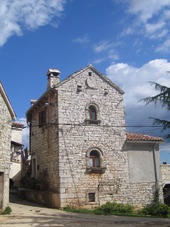to enlarge


or choose the place
from the menu below
 Rome |
 Byzantium |
 Venice |
 Vienna |
 Brioni |
 Smrikve |
 |
 |
 One stone sculpture was made in memory of the well that according to the sculpture was
made by Giuseppe Rencich di Mattio in 1863. Another sculptures is placed near to the roof of the house above two intersting
windows with vault and shows a Bishop. Below the sculpture there is a stone inscription.
One stone sculpture was made in memory of the well that according to the sculpture was
made by Giuseppe Rencich di Mattio in 1863. Another sculptures is placed near to the roof of the house above two intersting
windows with vault and shows a Bishop. Below the sculpture there is a stone inscription.
Zminj is located in a rural area and there are some very good agritourisms where you can taste some good Istrian food. In the village Paladnjaki, the family Milicic run the agritourism Paladnjaki and could prepare some good food for you. Another place that is also recommended is located in the village Krculi.
In Krculi, Bozac family, was one of the first families that started to run the agritourism. There are two other agritourisms near Zminj. The first one is located in Katun Lindarski and run by family Saina. It is named Ograde. The other one is agritourism Ferlin located in Grzini and it is run by the family Ferlin.
In Zminj’s photo gallery you will find few pictures of this village located in the central and southern part of Istria.
ZMINJ – HISTORICAL OVERVIEW
Zminj was a fortified village many centuries ago and some remains from the Byzantine period could define that this is the starting point of its history.
During the mid of the 20th century an important Slav necropolis, with graves from the 9th and the 11th centuries was found not far away from Zminj.
Zminj belonged to Bishops from Porec but like many other central Istrian territories also Zminj during the 12th century passed to the Count Mainardo of Schwarzenburg, the Lord of Pazin.
Zminj is mentioned for the first time in a document of the Pope Alessandro III from 1177 that confirmed that the jurisdiction over its churches belonged to the Bishops from Porec. At the time Zminj was named Zemin while at the end of the 15th century was named Schwing.
Zminj was one of the most important towns of the County of Pazin together with Gracisce, Tinjan and Lindar.
In 1374, also Zminj, together with other towns and villages that belonged to the County of Pazin, passed to the Austrian Hapsburg family. Zminj was located on the border of Austrian dominions in Istria and like most other border towns suffered many different wars between Austria and Venice over the centuries.
The most important wars were in: 1421, 1508 - 1509 and from 1616 until 1618. There is one family that had influence in Zminj in the 15th and 16th century and was the family of the Lords of Krsan.
From some documents can be seen that in 1543 Zminj was given as guarantee for a loan. Other families that in that period had interest over Zminj were: family Mosconi, Valvasor and family Krofftzhover. There is also a tombstone conserved in the Parish Church of St. Michael of one of them that dates back into 1445.
Zminj was for centuries part of Austrian dominions in Istria and in the 19th century was part of the Austro-Hunagrian Monarchy. Like most other Istrian towns and villages also Zminj was for a short period of time under Napoleon domination.
After the First World War and fall of the Austro-Hungarian Monarchy, Zminj, was part of Italy and after the Second World War became part of Yugoslavia (Croatia).
During the Italian Fascist period in Istria many Istrian families suffered from the regime or had to leave Istria. Fascism in Istria applied various repressive measures mostly towards Slav populations and this created the Antifascist Movement.
The Second World War was a very painful experience for the Istrian population and many innocent Istrians, both Slav and Latin, died during that war.
After the second World War Zminj became part of Yugoslavia (Croatia). There were three agreements between Yugoslavia and Italy which established that Istria would become a part of Yugoslavia: Paris Agreement of 1947, London Memorandum of 1954 and the Osimo Agreement reached in 1975.
In the first decade after the Second World War many Istrians, especially those living in towns and villages that for centuries were part of the Venice Republic, decided to leave Istria.